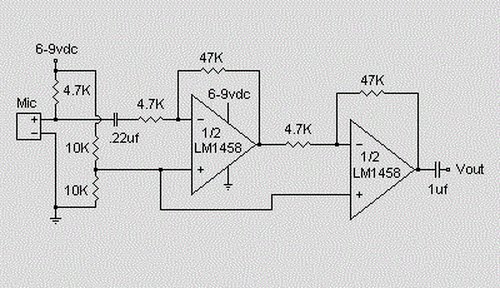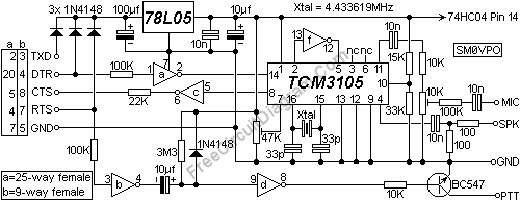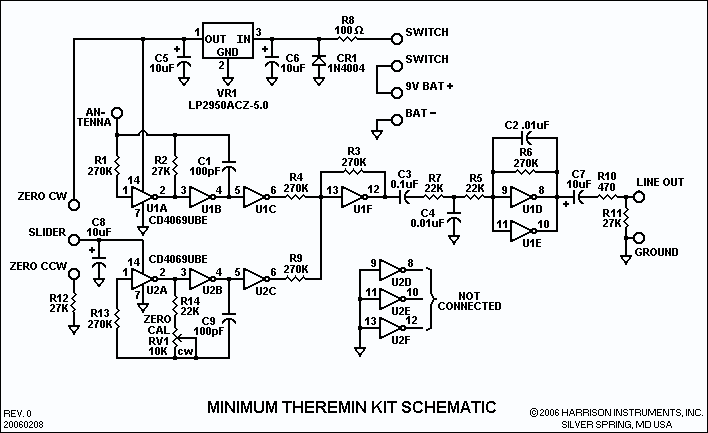
Microphone Condenser Pre Amplifier Circuit

This is a simple preamplifier circuit designed for an electret condenser microphone, utilizing an LM1458 dual op-amp integrated circuit (IC). The circuit amplifies the audio signal from the condenser microphone, allowing it to be used as an input for devices that typically do not accept microphone-level signals. A power supply of 6-9 volts is required for operation. The output level of the microphone amplifier can be adjusted by connecting a 10kΩ potentiometer. The circuit's gain can be increased by modifying the value of the 47kΩ resistor, depending on the input sensitivity of the main amplifier system. The microphone should be housed in a small round enclosure.
The described preamplifier circuit serves as an essential interface for electret condenser microphones, which are commonly used in various audio applications due to their compact size and sensitivity. The LM1458 dual op-amp IC is a versatile component that provides two independent, high-gain, frequency-compensated amplifiers. In this configuration, one op-amp is utilized for amplifying the microphone signal, while the second can be used for additional processing or buffering if needed.
The circuit design begins with the electret condenser microphone, which converts sound waves into an electrical signal. The output from the microphone is typically very low, necessitating amplification to bring it to a usable level. The LM1458 is powered by a supply voltage ranging from 6 to 9 volts, which is sufficient to ensure optimal performance while preventing distortion.
The gain of the preamplifier can be adjusted through the 47kΩ resistor. By increasing this resistor's value, the gain of the circuit can be enhanced, allowing for better sensitivity and performance with various microphone types. The 10kΩ potentiometer allows for further customization of the output level, providing flexibility depending on the requirements of the subsequent audio processing equipment.
For optimal performance, it is advisable to house the microphone and associated circuitry in a small round enclosure. This helps to reduce unwanted noise and interference while providing a neat and compact design. Proper grounding and shielding techniques should also be employed to minimize hum and ensure a clean audio signal output. Overall, this preamplifier circuit is a practical solution for interfacing electret condenser microphones with devices that require higher signal levels.This is a simple preamplifier circuit for electret condenser microphone. using a LM1458 dual op amp IC. The circuit takes the audio signal rom the condenser microphone and amplifier it, so you can use the microphone as the input to some device which wouldn`t normally accept microphone level signals. The circuit requires a 6-9 volt supply. Output of the microphone amplifier can be made variable by connecting a 10k © potentiometer. Circuit`s gain can be increased by men perbesar the value of 47K, depending on the input sensitivity of the main amplifier system. The microphone should be housed in a small round enclosure. 🔗 External reference
The described preamplifier circuit serves as an essential interface for electret condenser microphones, which are commonly used in various audio applications due to their compact size and sensitivity. The LM1458 dual op-amp IC is a versatile component that provides two independent, high-gain, frequency-compensated amplifiers. In this configuration, one op-amp is utilized for amplifying the microphone signal, while the second can be used for additional processing or buffering if needed.
The circuit design begins with the electret condenser microphone, which converts sound waves into an electrical signal. The output from the microphone is typically very low, necessitating amplification to bring it to a usable level. The LM1458 is powered by a supply voltage ranging from 6 to 9 volts, which is sufficient to ensure optimal performance while preventing distortion.
The gain of the preamplifier can be adjusted through the 47kΩ resistor. By increasing this resistor's value, the gain of the circuit can be enhanced, allowing for better sensitivity and performance with various microphone types. The 10kΩ potentiometer allows for further customization of the output level, providing flexibility depending on the requirements of the subsequent audio processing equipment.
For optimal performance, it is advisable to house the microphone and associated circuitry in a small round enclosure. This helps to reduce unwanted noise and interference while providing a neat and compact design. Proper grounding and shielding techniques should also be employed to minimize hum and ensure a clean audio signal output. Overall, this preamplifier circuit is a practical solution for interfacing electret condenser microphones with devices that require higher signal levels.This is a simple preamplifier circuit for electret condenser microphone. using a LM1458 dual op amp IC. The circuit takes the audio signal rom the condenser microphone and amplifier it, so you can use the microphone as the input to some device which wouldn`t normally accept microphone level signals. The circuit requires a 6-9 volt supply. Output of the microphone amplifier can be made variable by connecting a 10k © potentiometer. Circuit`s gain can be increased by men perbesar the value of 47K, depending on the input sensitivity of the main amplifier system. The microphone should be housed in a small round enclosure. 🔗 External reference




